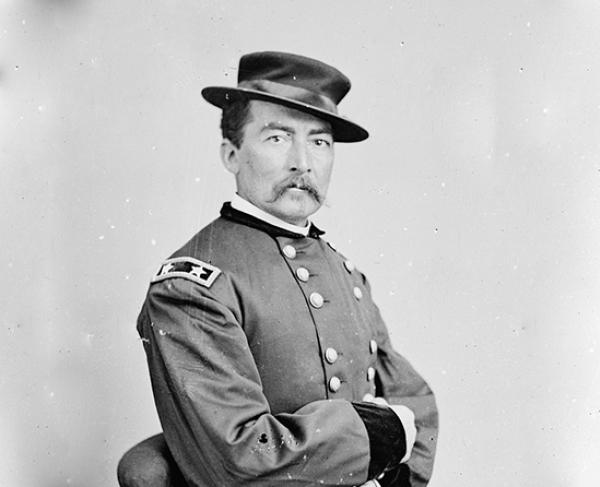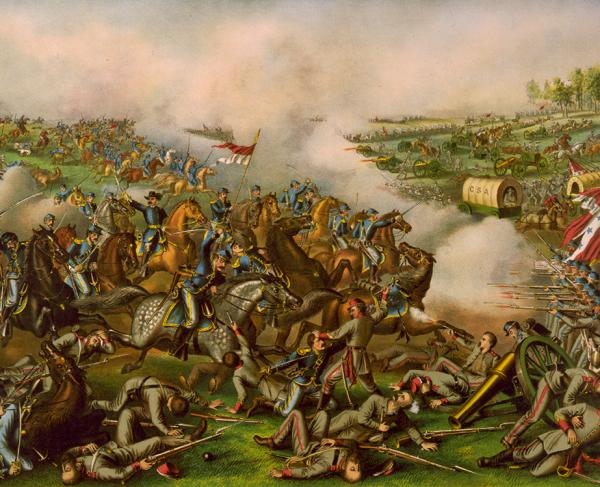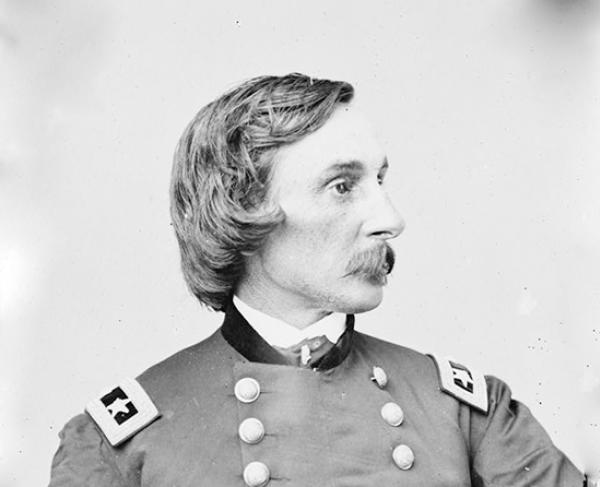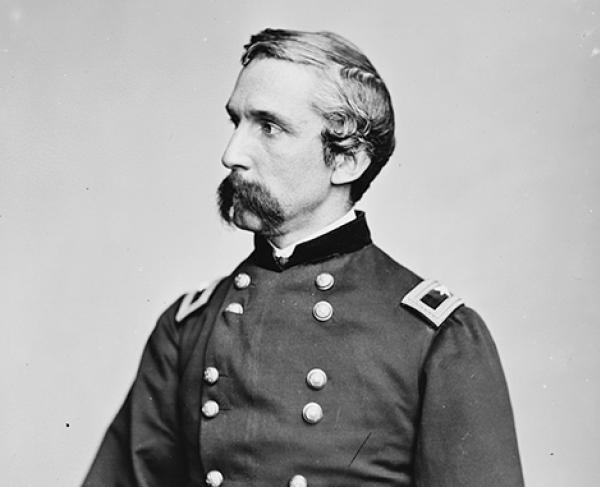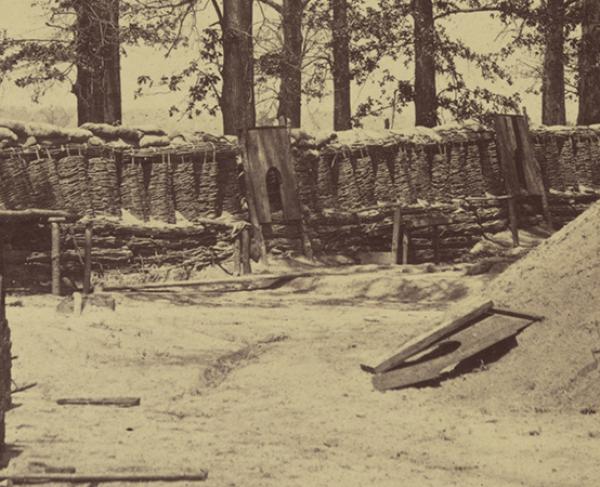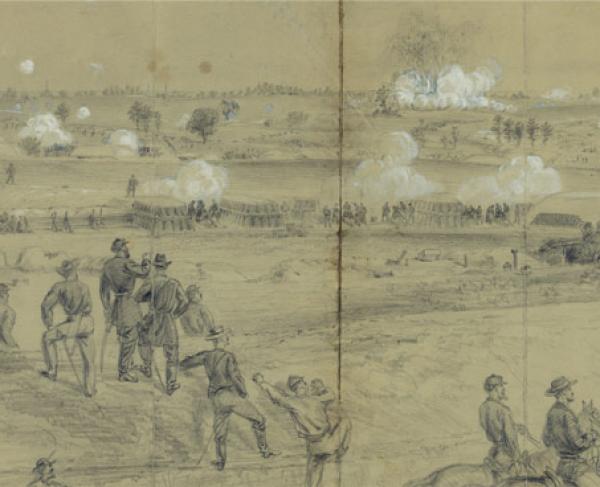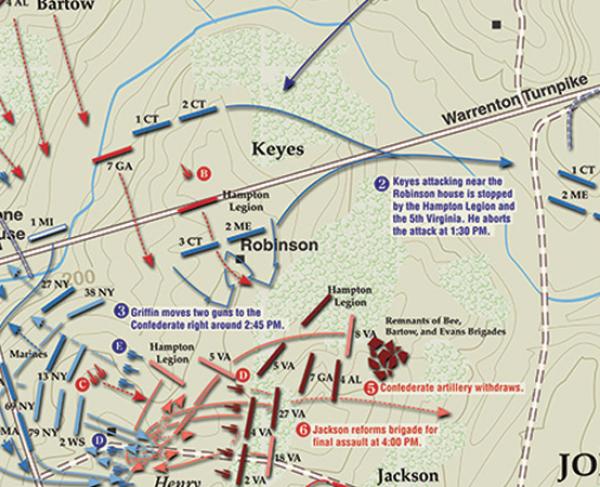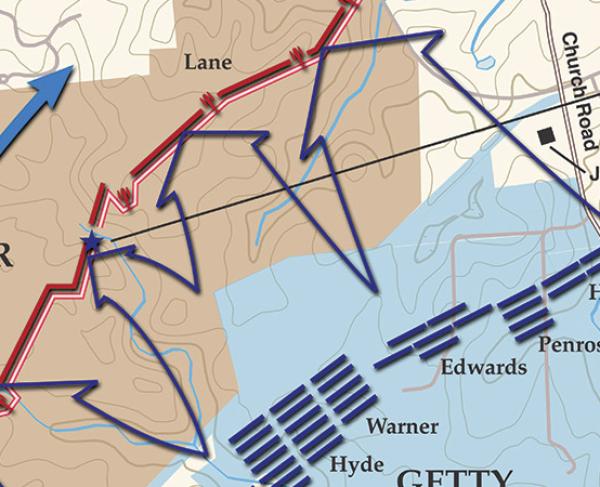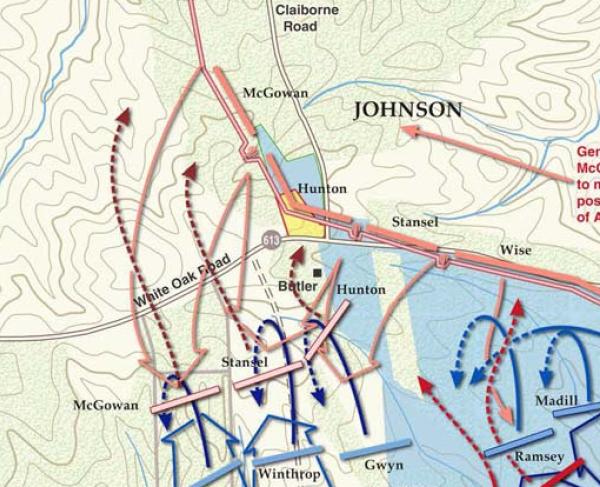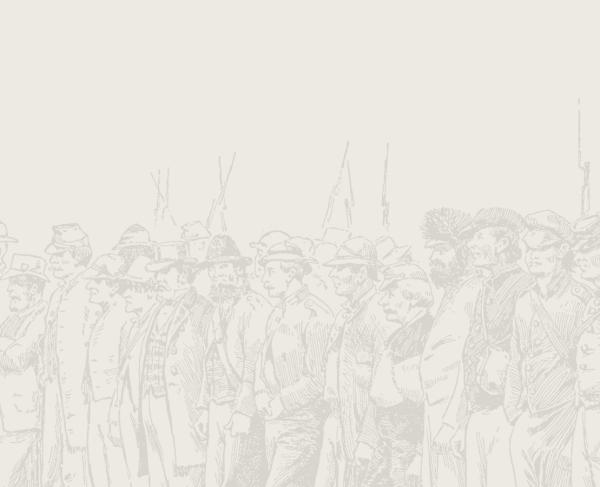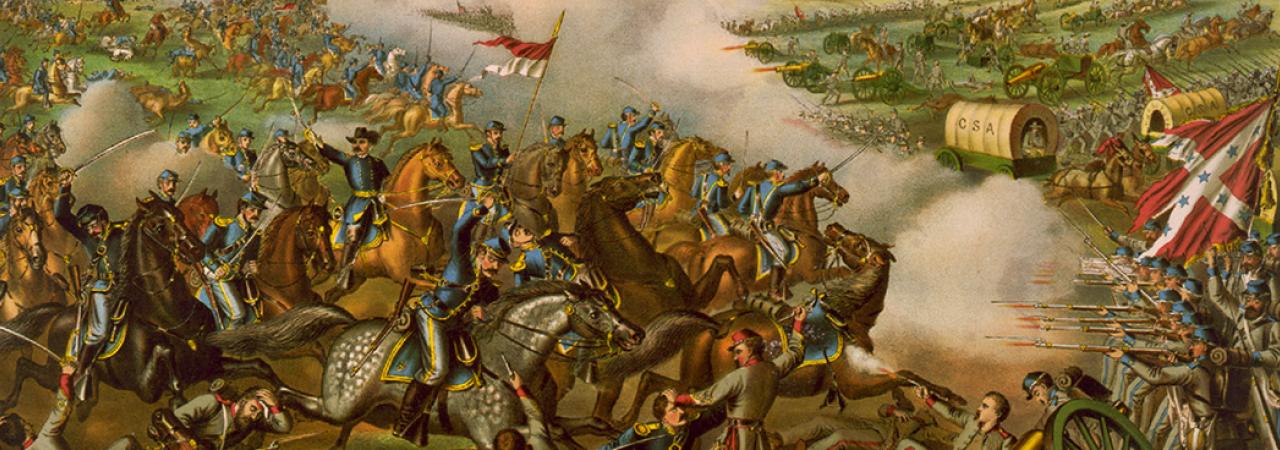
Maj. Gen. Phil Sheridan leads the Union charge at the Battle of Five Forks, Va. in this 1886 Kurz & Allison lithograph.
Five Forks
Dinwiddie County, VA | Apr 1, 1865
In the early spring of 1865, Union Gen. Ulysses S. Grant had stretched Confederate Gen. Robert E. Lee’s lines to their breaking point in the Petersburg Campaign. On April 1, Union forces captured the intersection of Five Forks, cutting Lee’s final supply line.
How It Ended
Union victory. After pinning down their right and center, Union Infantry of the V Corps under Gen. Gouverneur K. Warren attacked the weak Confederate left flank, resulting in a rout and capture of over 4,000 Confederates.
In Context
In the spring of 1865, after besieging Confederate Gen. Robert E. Lee at Petersburg, Virginia, for nearly nine months, Union Gen. Ulysses S. Grant stood poised to strike a fatal blow. Grant planned to stretch Lee’s lines to the west of Petersburg and hopefully threaten his supply lines or cause a breakthrough. Grant set his sights on Five Forks, the junction of five different roads in Dinwiddie County. To hold the area, Grant sent Gen. Philip Sheridan’s Cavalry and the V Corps under Ge. Gouverneur K. Warren to capture the vital crossroads and sever Lee’s remaining supply line.
Grant ordered Gen Philip Sheridan and his cavalry to advance on the Southside Railroad through an important road junction known as Five Forks. Lee countered this move by ordering Gen. George Pickett, with his infantry division and cavalry under Gen. Fitzhugh Lee, to hold the vital crossroads “at all hazards.” After discovering the Confederate force, Sheridan requested Union infantry support from Gen. Gouverneur K. Warren’s nearby V Corps. After briefly stalling the Union advance at Dinwiddie Court House on March 31, Pickett withdrew his command to Five Forks and fortified his position.
On April 1, 1865, Union Gen. Philip Sheridan’s cavalry force made it to the crossroads at Five Forks but found Confederate Gen. George E. Pickett’s men entrenched. Sheridan decided to attack the Confederate line but, in doing so, needed infantry support from Gen. Gouverneur K. Warren’s V Corps. However, Warren’s infantry became confused during their march and was subsequently slowed down in their advance into the area. At around 4:00 p.m., Warren’s men were finally in line and ready to attack.
Just as the battle opened, Gen. Thomas Mumford, one of Pickett’s commanders, sent a courier in search of the absent generals to inform them that an attack by Federal infantry was imminent. During the lull Pickett and Fitzhugh Lee decided to join a shad-bake at a nearby farm and left their commands without designating anyone to hold command while they were gone. As a result, no one was in overall command when the attack began.
As Sheridan moved his dismounted cavalry divisions towards the right and center of the Confederate lines, the V Corps moved towards the Confederate left. However, confusion plagued the command once the V Corps attack got underway. After realizing that the Confederate lines on the left flank made an angle rather than a straight line, the Federal attack started to unravel. As a result, the division intended to strike the front of Pickett’s line, under Gen. Romyaen Ayres, attacked the angle. Instead, Ayres wheeled his men toward the angle while the divisions of Samuel W. Crawford and Charles Griffin, whom Ayres needed for support, marched off past the angle, and both missed Pickett’s line completely. However, quick thinking by Joshua Lawrence Chamberlain, the hero of Little Round Top at Gettysburg, helped turn the situation around. Commanding a brigade in Griffin’s division, he noted with grave concern the growing gap between his brigade and Ayres’ division, which he could see was heavily engaged attacking the angle. Exercising superb command judgment, he turned his brigade and attacked on Ayres right. Upon seeing Chamberlain’s bold move, Griffin realized what was happening and followed with the rest of his division.
The fire from Pickett’s men was deadly, and while Ayres’ and Chamberlain’s men were virtually on top of the Confederate breastworks, the attacks began to lose momentum. Once the battle was underway, Pickett and Fitzhugh Lee were still unaware of the growing fight. This ignorance was partly due to a rare occurrence known as an acoustic shadow, where the sound dissipated in the forest surrounding the area. Unfortunately, it was already too late when the two vacant generals realized what was happening. After making it onto the battlefield, Pickett saw his entire line disintegrate and fold under the immense Federal pressure.
830
2,950
By the late afternoon, most Confederate resistance had been stomped out, and well over a thousand of Pickett’s men were captured. Lee was ultimately forced to evacuate both Richmond and Petersburg the following day.
The Five Forks area was located near Confederate Gen. Robert E. Lee's last supply line, the South Side Railroad. Grant hoped that if he could capture the area and cut the railroad, Lee would not only have to divert more men to Five Forks but weaken his force at Petersburg, allowing Grant to easily break through Lee's lines and destroy the Confederates.
During the lull between both sides for the majority of April 1st, Pickett and Lee were led to believe the only Federal force to their front was Philip Sheridan’s smaller cavalry force. Because of the lull, both generals decided to join in a shad-bake, a Fish meal that celebrates the start of Spring in Virginia, at a nearby farm. Unfortunately, since the area was covered with hills and thick trees, the Confederate commanders could neither hear nor see the battle when it started. This odd phenomenon is an acoustic shadow caused by the sound waves of a battle dissipating into the forest blocking the sound of battle. As a result, it was entirely too late when the two generals arrived on the scene just as the battle was ending.
Five Forks: Featured Resources
All battles of the Appomattox Campaign
Related Battles
22,000
10,600
830
2,950
